February’s webinar features Dr. Christina Dobbs, director of the English Education for Equity and Justice program at Boston University.
Click below
February’s webinar features Dr. Christina Dobbs, director of the English Education for Equity and Justice program at Boston University.
Click below
This blog is written by Katie Kelly to remind us how and why to teach a more current and accurate history curriculum. Read more about Katie at the bottom of her post.
Looking Back
For far too long, social studies has been taught (if taught at all) through a teacher-centered model comprised of lectures, note-taking, and task-oriented textbook reading. Students are assigned chapters with questions to answer and are later tested on the content. History becomes rote memorization of key dates and figures without meaningful context or deep learning. Therefore, we should not be surprised that many students lack understanding of significant historical events and find social studies both boring and irrelevant. A 2020 survey of adults under forty revealed that ten percent of respondents were unfamiliar with the Holocaust, and sixty-three percent of those surveyed did not know that over six million Jews were murdered in the Holocaust (Pew Research Center, 2020).
This is frightening and concerning. Not only do we need to ensure that young people are learning history but also that they are learning about it from multiple perspectives in order to weave a more complete tapestry of truth. Dr. Gholdy Muhammad (2020) reminds us to consider how our curriculum and instruction help us understand power, equity, and anti-oppression. Our teaching practices must be responsive to the historical events that shape the present if we aim to help students understand content from marginalized perspectives (Muhammad, 2020).
Teaching Today
Textbooks remain the primary source of social studies content in many classrooms (Brophy & Alleman, 2009). One problem with relying solely on textbooks is that they are designed as an overview of vast periods of time and lack depth and breadth on specific topics. As a result, textbooks often convey oversimplified information and are frequently told from a single perspective that omits the voices and stories of historically marginalized groups (Yearta & Kelly, 2021). This results in a narrow, biased, white-washed curriculum. Sanitized versions of history induce a sense of patriotism while ignoring the complicated past and present (Demoiny & Ferraras-Stone, 2018). As James W. Lowen writes in Lies My Teacher Told Me: Everything Your American History Textbook Got Wrong (2018),“The stories that history textbooks tell are all predictable; every problem has already been solved or is about to be solved… Textbooks exclude conflict or real suspense. They leave out anything that might reflect badly upon on national character.”
We cannot ignore our complicated and difficult past if we seek a better tomorrow for future generations. To foster increased engagement in learning a more complete and accurate history, we must build our capacity and willingness to include multiple perspectives and acknowledge that every perspective is true and partial (Hamilton et al., 2020).
Moving Forward
In order to teach a more complete and accurate history, we can incorporate multiperspective text sets including books, articles, primary sources, multimodal resources, etc. featuring the stories and perspectives that have traditionally been silenced or marginalized. Multiperspective text sets help students layer their learning about complex history to develop a more nuanced and accurate understanding of how it influences the present. When students have opportunities to connect the past to the present, history becomes more relatable and relevant to their lives (Kelly et al., 2023).
In our book, Critical Comprehension: Lessons for Guiding Students to Deeper Meaning (2023), we offer a multiple read framework to help students move beyond passive acceptance of information towards a deeper critical analysis of text by questioning the author’s intent, the information included/excluded, how the text positions the reader, and who benefits or is harmed by it. The return read seeks to disrupt and interrupt widely accepted narratives, the writer’s intention, and the reader’s stance to uncover hidden truths. This return read, or critical read, is necessary when examining the ways in which history is presented. As readers deconstruct texts, they think critically about historical and current events to examine power relations revealed in text and mirrored in society (Jones, 2006; Vasquez, 2010).
Sample questions for critical reading:
These questions serve as a framework to help students move beyond the dominant narrative to explore counter narratives and expand their perspectives and understanding of our country’s past and present. History textbooks often center the stories of the victor, the hero, the white male. For example, we think of our founding fathers and our first president and general of the Continental Army who led us toward independence. The Declaration of Independence stated that all men were created equal. We celebrate the Fourth of July with displays of patriotism from waving flags, red, white and blue clothing, parades, and fireworks displays. Yet, history textbooks rarely explain that neither women nor people of color had independence and freedom. In fact, slavery was not abolished for another 86 years when Abraham Lincoln signed the Emancipation Proclamation. Even then, it took three years for this information to reach enslaved people in Texas. On June 19, 1865, federal troops traveled to Galveston, Texas, to bring the news of freedom. This day has been commemorated as Juneteenth, and though Black citizens have long celebrated it, it has largely been overlooked until recently. Juneteenth became a federal holiday in the U.S. in 2021 amidst continued activism and the momentum of the Black Lives Matter movement. Teaching about Juneteenth is one way to help students bridge the past to the present to learn the nuanced and more complete truth of this part of U.S. history. This Book Buzz blog post offers a sample text set to help students deepen their understanding of the importance of Juneteenth.
Our country has a long history of centering the power of dominant voices. This perspective is privileged in the curriculum in our schools as well. Therefore, we must work to ensure that multiple perspectives are included when teaching social studies. Consider your own school experiences. What were you taught? What weren’t you taught? Whose stories were included? Whose were left out? How did that shape your beliefs about the world and your place in it? (Kelly et al., 2023).
Critical comprehension requires deeper reading to consciously question the text, the world, and the stories we’ve been told. Critical readers seek a more nuanced understanding by uncovering silenced voices, omitted narratives, and multiple perspectives needed to weave a more informed and complete tapestry of truth.
References
Brophy, J., & Alleman, J. (2009). Meaningful social studies for elementary students. Teachers and Teaching, 15(3), 357– 376.
Demoiny, S.B. & Ferraras-Stone, J. (2018). Critical Literacy in Elementary Social Studies:
Juxtaposing Historical Master and Counter Narratives in Picture Books. The Social Studies, 109(2), 64-73.
Hamilton, D.M., Wilson, G.M., & Loh, K.M. (2020). Compassionate Conversations: How to speak and listen from the heart. Boulder, CO: Shambhala.
Jones, S. (2006). Girls, social class and literacy: What teachers can do to make a difference. Portsmouth, NH: Heinemann.
Kelly, K., Laminack, L. & Vasquez, V. (2023). Critical Comprehension: Lessons for Guiding
Students to Deeper Meaning. Thousand Oaks, CA: Corwin Press.
Lowen, J. W. (2018). Lies My Teacher Told Me: Everything Your American History Textbook Got
Wrong. New York: The New Press.
Muhammad, G. (2020). Cultivating Genius: An Equity Framework for Culturally and Historically Responsive Literature. New York: Scholastic.
Pew Research Center, Jan. 22, 2020, “What Americans Know About the Holocaust”. Retrieved from https://www.pewresearch.org/religion/2020/01/22/what-americans-know-about-the-holocaust/.
Vasquez, V. (2010). Getting beyond “I like the book”: Creating space for critical literacy in K-6 classrooms. Newark, DE: International Reading Association.
Yearta, L. & Kelly, K.(2021). Digital Storytelling to Enhance Social Studies Content Knowledge, Explore Multiple Perspectives, and Advocate for Social Justice. In J. Tussey & L. Haas (Eds.). Connecting Disciplinary Literacy and Digital Storytelling in K-12 Education. IGI Global.
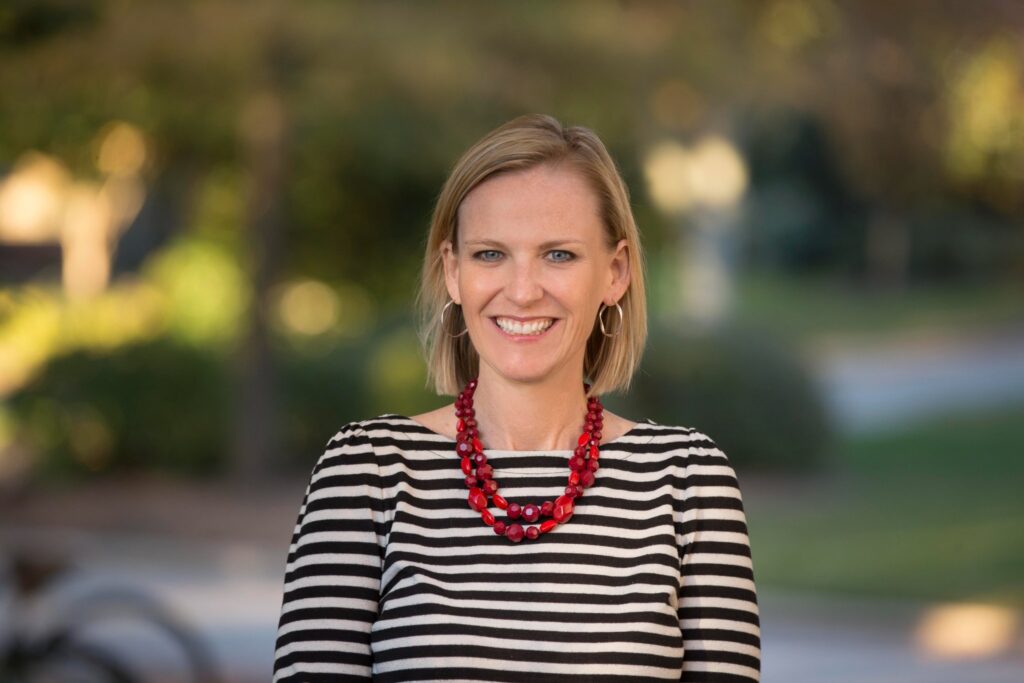
This post was written by Ian O’Byrne. You can read more about Ian at the bottom of this post.
In recent years, there has been a growing trend of anti-truth legislation being introduced at the state and local levels. These bills often target discussions of race, gender, and other sensitive topics in public schools. While framed as bans on teaching Critical Race Theory (CRT) or LGBTQ issues, legislation such as this is ultimately a ban on truth and history that impinges on K-12 educators’ First Amendment rights and threatens to upend the structure of education law and policy. As educators, it is important to be aware of these bills and to take steps to advocate for the right of all students to learn about the full and accurate history of our country.
This past year, the South Carolina Transparency and Integrity in Education Act (H.3728) sought to prohibit “certain concepts from being included in public school instruction and professional development” and to provide a means for addressing violations. The bill wanted to prohibit the teaching and training on concepts related to race, religion, politics, gender, gender identity, and sexual orientation. Supporters suggested it’s a way to stick to state education standards while opponents say it opens the door to censorship.
It is important to note that this is one of many anti-truth pieces of legislation that we’re seeing across the country.
This legislation is organized and funded by groups like the Heritage Foundation as they provide templates to allow lawmakers and copy/paste into bills. Review the CRT legislation tracker from the Heritage Foundation here.
Anti-truth legislation refers to laws that restrict or prohibit the teaching of certain historical or factual information, which can be seen as a violation of the First Amendment rights of K-12 educators and students.
The First Amendment to the United States Constitution protects the freedom of speech, religion, press, assembly, and petition. In the context of this post, the First Amendment applies to the constitutional protections afforded to K-12 teacher speech and the potential violations of those protections by anti-truth laws. Anti-Truth laws impinge on K-12 educators’ First Amendment rights by restricting or prohibiting the teaching of certain historical or factual information, which can be seen as a violation of the freedom of speech.
I understand that legislation such as this serves as a chilling effect on educators and students. Not many educators at this point are challenging these laws on First Amendment grounds. This may be due to teachers not wanting to test these boundaries, due process, or established legal precedents.
In the tumultuous landscape of modern education, book bans, stifling class discussions, and curtailed written work have emerged as alarming consequences of anti-truth legislation. As educators grapple with navigating these challenging times, the very essence of intellectual freedom is put to the test. Book bans, often driven by ideological agendas, limit students’ access to diverse perspectives and critical thinking, hindering their ability to develop a well-rounded understanding of complex issues.
Likewise, stifling class discussions on controversial topics suppresses the exchange of ideas, hindering the development of open-mindedness and empathy. Concurrently, stringent restrictions on written work can restrict students’ creativity and force self-censorship, stifling their growth as independent thinkers. In the face of anti-truth legislation, educators and advocates must unite to safeguard the fundamental pillars of education, fostering an inclusive, truth-seeking environment that empowers students to become informed, engaged citizens ready to navigate a complex world.
One of the most important things that educators can do is to stay informed about anti-truth legislation in their state and local area. There are a number of organizations that track this legislation and provide resources for educators, such as the Education Law Center and the American Civil Liberties Union. This spreadsheet from PEN America helps keeps track of these bills. Once you are aware of the bills that have been introduced, you can take steps to educate your community about the importance of these issues.
Another important step is to interact with policymakers, school boards, and parents. This can be done by writing letters, attending public meetings, and speaking out at school board meetings. It is important to be respectful and to present your arguments in a clear and concise way. You can also encourage your students to get involved in advocacy efforts.
It is important to remember that the First Amendment protects the right to free speech. This means that schools cannot censor discussions of race, gender, or other sensitive topics simply because some people find them uncomfortable. If you believe that your school is violating your First Amendment rights, you should contact the American Civil Liberties Union, The ProTruthSC Coalition, SC United for Justice and Equality, or another organization that can provide legal assistance.
This protection extends not only to educators but also students in schools. Students could challenge these broader laws by arguing they have a First Amendment right to take in lessons and information from schools.
Advocacy and activism can be challenging, but it is essential to protect the right of all students to learn about the full and accurate history of our country. By staying informed, interacting with policymakers, and educating your community, you can make a difference in the fight against anti-truth legislation.

Ian O’Byrne is an associate professor of literacy education at the College of Charleston in South Carolina. His research focuses on the dispositions and literacy practices of individuals as they read, write, and communicate in online and/or hybrid spaces. His work can be found on his website (https://wiobyrne.com/) or in his weekly newsletter (https://digitallyliterate.net/).
This post is written by Tori Young. Read more about Tori at the bottom of this post.
As educators, we are masters at adapting to new scenarios and thinking on our feet. Whether it is behavioral challenges in the classroom, changing grade levels or content areas, or being told a new acronym that will guide our students to academic achievement. While the patterns stay the same, change remains the one constant in our world. In a time of attention on literacy policy in our public schools, what do we do as educators when our curriculum is criticized, and our livelihood is on the line? And how do we engage students in the process of not only understanding the necessity to examine policies but also how to do this and why?
In secondary history, many communities have questioned the intentions behind the curriculum presented. Talks of Critical Race Theory and indoctrination have instilled fear in parents and policymakers for the minds of students as they become passionate voices in movements for climate change, women’s rights, and racial equality. As teachers, the impact we have on a student is apparent, and sadly there are few enough instances of teachers abusing that role to teach their own agendas. In a time of great societal change and political bipartisanship, parents have expressed their concern for their children’s beliefs being influenced. As teachers, a lot of this skepticism falls upon us, even though forceful influence is very rare to see and is quickly reprimanded. Yet, we fall victim to the fear for our careers when discussing important, yet sensitive issues. Fear is valid, even if it is a small number that has created cause for concern. Fear should not prevent us, however, from doing our job of teaching true history.
True history is based on facts and first-hand accounts. Primary sources are the best accounts we have of our world before modern media, but a good historian is aware that these diaries and newspaper articles are just as full of bias. Our role is to teach students how to spot perspectives through context and draw their own conclusions based on facts. This skill is what makes not just a good historian, but a great citizen. Evaluating the world and the policies that impact our lives through an unbiased narrative is nearly impossible. Teaching students how to maintain their own beliefs, while also educating themselves with facts and truths is far from indoctrination. Instead, it is the foundation of a true democracy. Our republic is made up of diverse cultures, lifestyles, and needs. Raising a voting population that can make change for their communities while respecting the various opinions and preferences of other citizens is what makes a democracy free and fair. When teaching tough subjects such as religion, slavery, and civil rights, have students follow up the lesson with reflection. Depending on the classroom environment, it may be good to have a discussion so that students can hear and learn from each other’s perspectives. In some cases, it may be beneficial to have students write down their beliefs and receive unbiased feedback from the teacher to ensure that they understand the content while knowing that their views are validated and safe in the classroom.
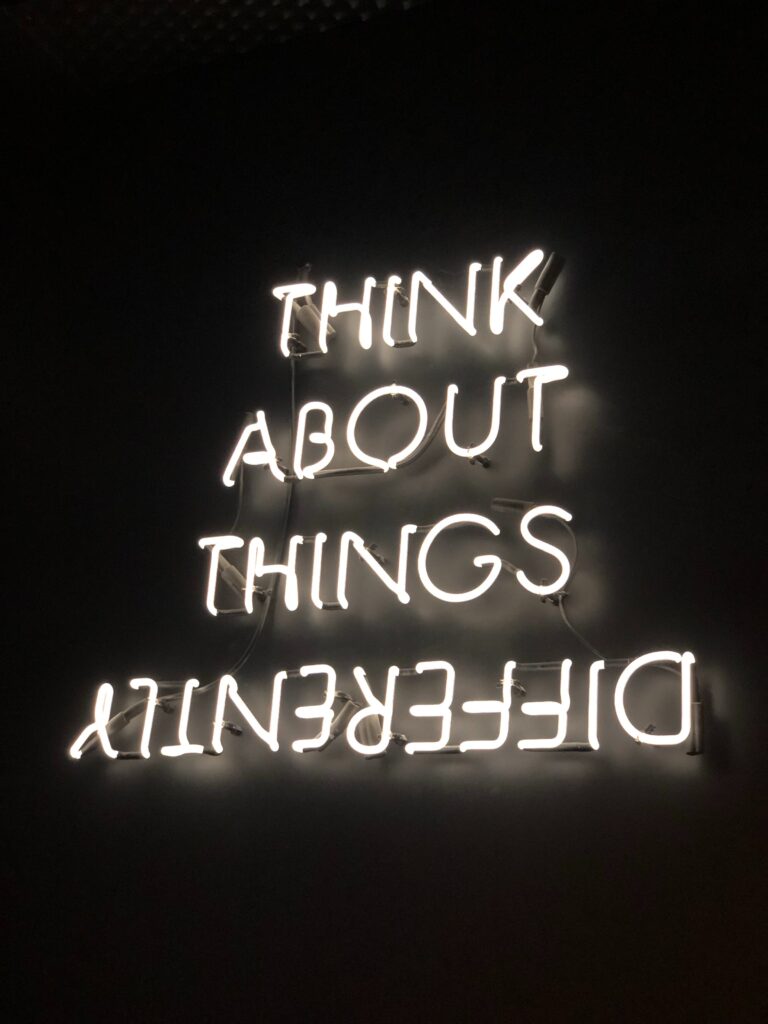
As policies in schools change, students do not always have the context. By pointing out instances in history where similar changes have occurred, showing the verbiage of standards and indicators, and creating discussion in the classroom about policy that impacts students directly, they are practicing this critical thinking skill. By questioning the “why” behind literary policy in our social studies classrooms, students can come to their own conclusions based on the facts and their personal beliefs. This may look like having students recall a previous reading from a social studies or ELA class and having them reflect on the overall message of the author. Then, students can share with a partner what they found and try to spot context – why the author thought the message would be important. Lastly, students can analyze the impact if that message was never received. For example, if George Orwell’s 1984 was never written, would there still be people who believed that the government was completely trustworthy? Why would it matter to question the government? Where do we see examples in history where questioning the government has created change? How might the world be different if governments were never doubted or challenged? Our curriculum may be judged and altered to fit the new narrative of society, but it does not have to be a hindrance. We are always living in history; the context just looks a bit different.
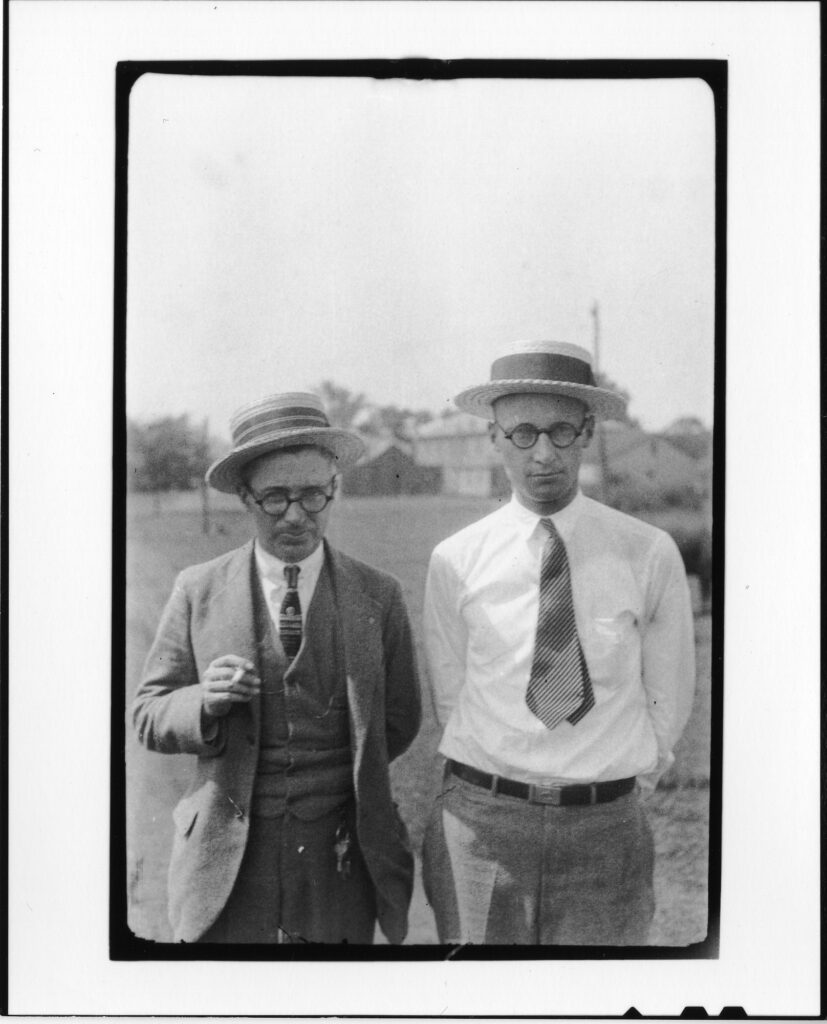
Schools have been at the forefront of societal change several times in United States history. Challenging separate but equal through Brown v. Board of Education, questioning religious influence in curriculum with the Scopes Trial, or providing equal opportunities regardless of gender with Title IX, schools have been an environment for questioning society and legislation as the new generation learns about the world that they live in. Having schools targeted and subdued for speaking true history is not a new phenomenon, and it is not a purely American phenomenon. That does not make the changes and adapting any less scary for educators, but it does follow a pattern. Studying history helps us learn from patterns, so don’t panic. Instead, acknowledge the signs of the times, and help your students connect the dots for themselves just like you have been doing all along.
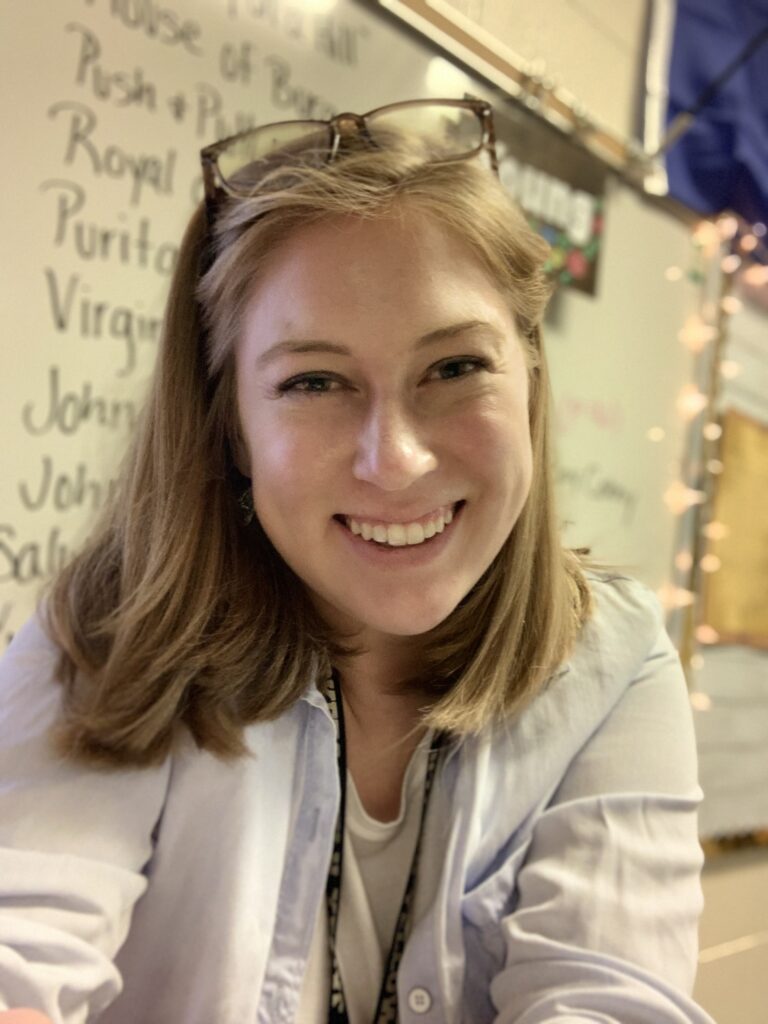
Tori Young is a high school social studies teacher in Anderson, South Carolina. She is currently working on her Master’s in Instructional Design and Learning Technology at Anderson University.
This post will discuss how “Where I’m From” poetry helped provide a scaffold to better understand multilingual students and their evolving identities. This post is written by Emily Graham. Read more about Emily at the bottom of this post.
The question “Where are you from” is one often heard by multilingual learners (MLs). Although all the MLs at my school could answer this question simply by naming their birth country as either the US, Mexico, or Guatemala, this answer gives little information about each student’s identity. Through her poem, “Where I’m From”, George Ella Lyon shows us how we can tap into the more complex answer to this question. Lyon links together memories of special places, people, sayings, and stories from her past to tell us who she is, and this can serve as a powerful model for reflection and exploration of the rich and diverse identities among students.
In a poetry unit built from Lyon’s ideas, structure, and themes, my MLs explored and shared their own identities. Students’ poems and thoughts gave me a small window into my students’ past and present lives and their critical and creative thinking abilities. The “Where I’m From” Poetry Project allowed me to build a deeper, more complex understanding of who my students are and “where they are from” beyond just a geographic place.
There are countless get-to-know-you activities that require students to answer categorical questions such as: “What are your favorite foods?”; “What are your favorite songs?”; “Who is in your family?”; or “What do you like to do when you are not at school?” While I believe these questions are important, their answers do not always provide great insight into our students’ lives. Often these questions are asked and answered without much thought or reflection. Students may say: “My favorite foods are tamales”; “I don’t know my favorite song”; “I live with my dad, aunt, uncle, and sister”; and “I watch T.V.”, but there is little depth or passion to these responses.
When we use poetry to elicit these responses, we can reframe these questions in a way that requires reflection and deep thinking. When the questions are reframed to: “What are the family, foods, thoughts, and stories that make you who you are?” a teacher can gain a much deeper understanding of students and their unique identities. “Where I’m From” Poems provide a frame and an artistic lens for students to respond to those questions about identity.
Here is an example of how one student’s poem provided me with a glimpse into his rich and unfolding identity. Looking at his identity from a more reflective perspective helped me build an understanding of the student’s home life, language, family, and interests that I had not slowed down to see before.
Jimmy, a 3rd-grade multilingual student, was born in the United States and struggled with academic language and literacy. Although he was born in the US, he did not begin learning English until he started school in kindergarten. The first language, the language used most often, and the language that he used with the people he loved, was Spanish. Jimmy was considered a student who “struggled” in school. He often put his head down in class, he refused to work independently, and said things like, “I’m not smart” or “I can’t read.” Sometimes he participated in whole group discussions but more often seemed disengaged. Jimmy’s class was starting a unit on poetry, and I anticipated resistance from Jimmy. I decided to teach a unit to build background knowledge and confidence in poetry.
Jimmy initially seemed disinterested in the idea of studying and writing poetry. But that slowly started to change through the process of a close read of Lyon’s “Where I’m From.” At first, we looked at the literal meaning of Lyon’s words through translations, pictures, and discussion. Jimmy was able to confidently define big words from Lyon’s poem such as “carbon tetrachloride” and “forsythia bush”. He was able to explain how someone might lose a finger to an “auger”. He also was able to discuss big ideas like nostalgia and memories. In later readings, Jimmy stated Lyon’s voice reading her poem sounded like a ghost. He said Lyon talked about the past and memories like a ghost would. Jimmy seemed to enjoy building on the ideas of his group members. He was not afraid to share his opinion on the meaning of certain phrases and his thoughts about word choice. I was surprised by Jimmy’s desire to build an argument and support a claim in the discussion. He said, “I think the author likes to play in the dirt under her porch. Maybe she liked to hide there because that is what I do. My dogs also like to hide under the porch because it is cool, and they feel safe.” I was also impressed by Jimmy’s critical thinking and questions. He said, “I wonder why she said the ‘it tasted like beets.’ Maybe she is talking about when she was a little kid because little kids always put stuff in their mouths. They are curious and that is how they explore.”
Jimmy was not initially thrilled about the task of writing his own poem. He needed some support organizing his ideas. With the support of graphic organizers, help in spelling, and some motivation from a YouTube student example, Jimmy wrote. Here is his poem:
I am from fish tanks and from dirt
and my dog DJ
I am from broken glass in my backyard
I am from my broken T.V.
From Roblox and road trips
I am from sunflowers and bamboo
I am from tag with my brother and helping my mom
from Joseph and Marissa
I am from the sad puppies and Llama the puppies mama
from swings and broken pinatas
I am from my dad’s Honda
with a big engine
I am from my mom’s Hyundai
it has a push button to start
from riding my bike and making my own adventures
I am from digging holes and making traps
I am from inventions
Jimmy’s poem was a powerful representation of his identity, and his word choice was beautifully poetic. He was able to infuse his poem with alliteration and repetition, imagery, and emotion. He juxtaposed happy and sad memories, and purposefully ended his poem with positive attributes about himself. He talked about both joyful and upsetting times with his family. Times where they celebrated together — “broken pinatas” — and times of trouble — “broken T.V.” From reading and talking about Jimmy’s poem, I learned about ways Jimmy interacted with his family, some challenges in his life, and personal characteristics that he was proud of. Jimmy was proud to explain how he helped his mom with daily chores and sometimes would go to work with his dad. He talked about his dog Llama having puppies and the irresistible sad look on the puppies’ faces. He found joy in playing with the puppies. He talked about being devastated when some of the puppies got sick and died. He said he felt so bad for Llama, the puppy’s mama. Jimmy sometimes showed insecurities in the classroom but spoke with complete confidence when discussing his adventures and inventions outside of the classroom. He talked about his positive attributes like creativity, curiosity, and bravery. Jimmy took pride in his poem, so much so that he wanted a copy to take home and read to his family
Jimmy’s poem and the conversations that resulted from discussing poetry helped me shift from focusing on Jimmy’s struggles to identifying and sharing his strengths Before, I might have shared my frustrations on Jimmy’s lack of motivation or refusal to do work in my class. Now I had something so much more powerful and beneficial to share with other teachers — Look what Jimmy wrote, look what Jimmy can read, but most importantly look at some of the things that make Jimmy who he is! Through poetry I learned more about his academic abilities — Jimmy could craft meaning from metaphor and explain his theories about themes and lessons hidden in poems. I also learned about his interests and motivators. I discovered Jimmy’s empathy for others, passion for inequalities in his community, and desire to help others. Jimmy’s poem allowed me to understand his uniqueness and make connections to my own childhood curiosities and adventures. I felt the same empathy for animals and dreams of a more peaceful and equitable world.
I had the same kind of revelations and connections with my other students. I learned Alexander had a job caring for sheep in Mexico through his lines: “I am from a big river where the sheep used to cross” and “from a scary ram who chased me all day.” I learned Veronica’s older brother always said to her “sup bro and dap me up, bro.” I learned about Marta’s memories of Guatemalan cuisine: “tortilla’s (sic), tortas, tamales, and tacos.” Each poem was beautiful and unique and a window into my students’ lives. These poems provided voice for my students and a platform to share the individual identities that they were proud of. This background was both unique and unifying. The poems gave students an opportunity to be more clearly seen and heard.
Sometimes we want to get to know our students, but we don’t know the right questions to ask. The question “Where are you from?” seems simple on the surface but does not have a simple answer. Studying George Ella Lyon’s poem with my elementary multilingual learners helped me slow down and deepen my understanding of Lyon’s words and, more importantly, my students’ words. Although my initial purpose of the poetry unit was to provide academic background knowledge for my students, a more beautiful and poetic thing happened — poetry provided background knowledge for my students for me. The poems provided a space for me to do the learning and for my students to do the teaching. The format provided a space to merge home life and home language with school life and language. “Where I’m from Poems” allowed us to celebrate each student’s beautiful and unique identity.
Lyon, G. E. Where I’m from, a poem by George Ella Lyon: Writer and teacher Subtitle. http://www.georgeellalyon.com/where.html
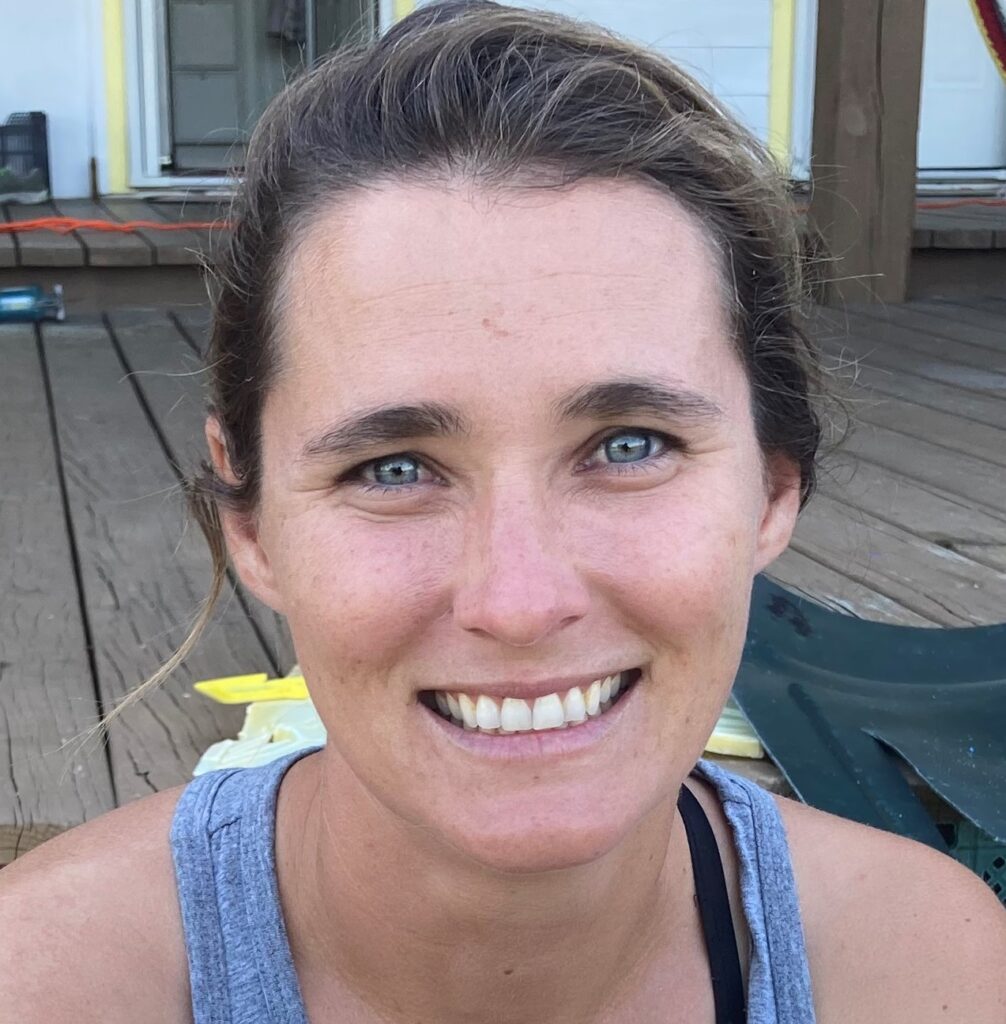
Emily Graham is from Johns Island, South Carolina. She currently teaches grades K-5 as a Multilingual Learner Specialist in Charleston County Schools. She is a certified elementary educator and has served in several different teacher roles including as a Multilingual Learner Program Specialist, a second grade teacher, an English teacher abroad, a substitute teacher, and a teacher’s assistant. She speaks Spanish and enjoys traveling, creating, and being in nature. She lives with her husband, 8-month-old girl, and two rowdy rescue dogs.
Cover Photo by Vidar Nordli-Mathisen on Unsplash
By: Amber Burton, Addison Lee, Nicole Mesimer, Kathleen Pennyway, and Eliana Pinckney
This list was developed by several students and teachers at Dreher High School. The students involved led a series of community gatherings called “Get Woke Talks” that centered around issues such as racism, gender identity, and activism. These recommendations come from the lived experiences of the writers. We hope you find them useful.

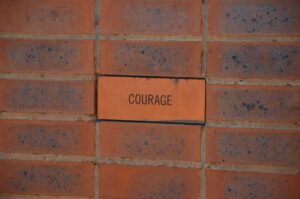
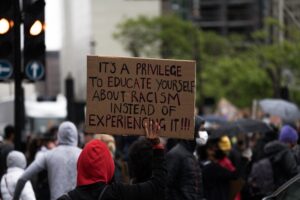
This list is not intended to be a complete list of everything you need to know about antiracist teaching, but hopefully this can give you some things to think about as you move forward in your journey. Some other resources you may find useful are listed below.
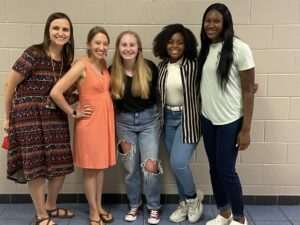
By: Nikki Griffin, North Carolina High School Social Studies Teacher
Many times in my career, as a classroom history teacher, I have come across colleagues who are fearful of being anti-racists. These mostly well-meaning teachers are by no means racists, but sometimes lack the courage to be ANTI-RACIST. Here is an important distinction to make for ourselves and for our students – being an anti-racist requires more of us than simply not being racist. Being anti-racist requires action, not just a disposition. Being anti-racist moves us to actively address issues of systemic racism in our schools and in our society. Being anti-racist demands expression of anti-racist ideas that directly challenge racist ideas.
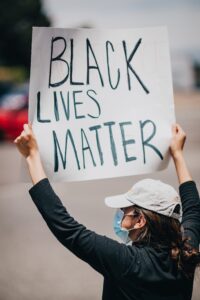
Last year, following the horrific murder of George Floyd and the proliferation of protests across the United States and the world in support of Black Lives Matter, I decided to put my own beliefs about being racist into action and to NOT hide behind my role as a teacher to remain on the sidelines of “teaching history” so I could avoid the more uncomfortable role of being anti-racist. Many of my students sent me messages expressing their sense of frustration that there was nothing they could do to be anti-racist or that they did not know how to show action to express their anti-racist views. My answer to them was almost always the same, “Let your voice be heard” or “Counter racist ideas with getting your own anti-racist ideas out there!” Very often, I would remind these students that they had spent a whole year or more studying history with me and that they had the arsenal of knowledge with which to arm their anti-racist actions. Finally, I decided to take my own advice, step out of my role as classroom teacher, and publish a video called “Opportunity Lost.” Actually, this is a video series that I am still working on and intend to finish this summer.
My message to teachers is that being a teacher does not mean you can not express your own views to the wider world. Just as you expand understanding of anti-racism in your classroom, your unique knowledge of your subject area, students, and community put you in a unique position to share ideas to the broader world to pursue the goal inspiring anti-racism in the world.
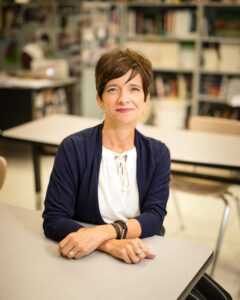
Nicki Griffin has taught high school social studies in North Carolina for 29 years with a focus on AP History and AP Art History Teacher. She attended East Carolina University in Greenville, North Carolina.
By: Antoinetta J. Rogers
“Schooling is the process by which you institutionalize people to accept their place in a society… Education is the process through which you teach them to transform it.”- Dr. Jeff Duncan-Andrade
This is a very common and loaded question. Asunción Cummings Hostin, Euphemia LatiQue Sumpter, Uzoamaka Nwanneka Aduba, and Antoinetta Jamika Rogers prove there is always a story behind a name.
Asunción Hostin is an American lawyer and a very intelligent, articulate, and charismatic cohost of the Daytime Emmy Award winning talk show The View. She is commonly known as Sunny Hostin. During an interview with People Magazine, Sunny stated that when she began working on Court TV with Nancy Grace, the famed legal commentator, she had a difficult time pronouncing her name. Acknowledging that Sunny was indeed quite talented, Nancy Grace feared that because most people may find it difficult to pronounce her name that she shorten it to make it easier to pronounce. So, instead of Asunción Hostin, Sunny Hostin is the famous household name. Euphemia LatiQue Sumpter is an American actress. Known for her flair, fortitude, and fascinating role on the highly acclaimed series Tyler Perry’s The Haves and Have Nots, she mentioned in an interview that although she was beautiful and talented the name Euphemia just was not “it.” So, instead of Euphemia Sumpter, Tika Sumpter is the famous household name.

Uzoamaka Nwanneka Aduba is a dynamic, vibrant, and effervescent, Nigerian American actress who is best known for her roles in the Netflix series Orange is the New Black and the film Miss Virginia. She is commonly known as Uzo Aduba. A video surfaced of Uzo stating that she hated her name. The hate seemed to stem from other people having a difficult time pronouncing it. Growing up in a small New England town, she explained that there were not a lot of Nigerian Americans. Uzoamaka means “The road is good.” What was quite noticeable in her candid oration was the visible mentioning of teachers finding it difficult to pronounce her name. One day upon returning home from school, she casually asked her mom to call her Zoey. Her mom simply stated that if people can learn to say Tchaikovsky, people will and would learn to pronounce Uzoamaka.
So, what does an English teacher from a small rural town in South Carolina have in common with the aforementioned Hollywood stars? Antoinetta Jamika Rogers is my name. Nobody calls me by my first name Antoinetta, instead I go by Jamie. Antoinetta has ten letters, four syllables and is often pronounced as (An-tw-un-Et) instead of (An-tw-un-Et-Uh). So, growing up Jamie was more adaptable and easier than Antoinetta. It became my nickname. Nicknames are convenient, but seldom created as a courtesy or in favor of the person in which the shortened name is given. What’s in a name? Absolutely everything! A person’s name is a huge and important part of a person’s cultural identity; therefore culturally responsive teaching is very imperative and quite a necessity to say the least in an ever changing and evolving world.
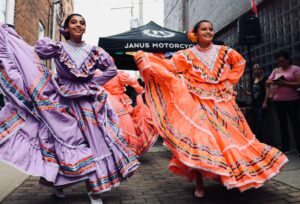
Culturally Responsive Teaching is the practice of teaching cultural competence. States and school districts already have educational standards and curriculums established that are usually adjusted and molded according to society’s norms. However, in the classroom it is so important that teachers make it a norm to not only teach, but practice cultural competence. Cultural competence is the ability to understand, communicate with, and effectively interact with people across cultures. One’s own awareness of cultural competence includes developing positive attitudes towards cultural differences and gaining knowledge of cultural practices and world views. I realized that regardless of the demographics of students I teach, classrooms should be increasingly diverse with diverse teaching materials, methods, and strategies. If the demographics are all the same, this does not mean that cultural competence and sensitivity should not be inclusive. All students should feel welcomed into a learning environment that celebrates diversity and multiculturalism. Most curriculums and lessons include an aspect of diversity, but it should be woven into the atmosphere of the classroom.

According to the Center for the Professional Education of Teachers (CPET), school practices currently reflect the norms of monolingual, white, middle class students, which often excludes students who come from diverse cultural and linguistic backgrounds. Students who are excluded from these norms are often viewed through a deficit lens. South Carolina College and Career Ready Standards are the standards that I am required to use as a certified classroom teacher. So, the overall goal is for students to be prepared to enter an institution of higher learning, the workforce, and/or the military. Not only should students be academically prepared, but students should be culturally prepared as well. Thus, a simple yet complex task of accepting and pronouncing an individual’s name can possibly have an everlasting positive impact.
Society has a habit of associating certain sounding names with certain races and ethnicities. According to the National Bureau of Economic Research Issue No. 9. “Employers’ Replies to Racial Names,” a job applicant with a name that sounds like it might belong to an African-American – say, Lakisha Washington or Jamal Jones – can find it harder to get a job. Despite laws against discrimination, affirmative action, a degree of employer enlightenment, and the desire by some businesses to enhance profits by hiring those most qualified regardless of race, African-Americans are twice as likely as whites to be unemployed and they earn nearly 25 percent less when they are employed. Pronouncing an individual’s name correctly and accepting that the name may have cultural attachment to it is important for the advancement of society.

I make sure that I pronounce a student’s name correctly as well as the student’s peers in my class because names represent a heritage, a lineage, and a legacy. This is also common courtesy and a sign of respect. A name is a representation that we should be proud of and not something that anyone, in this case specifically students, should have to worry about changing or shortening in the future, because we live and exist in a society where certain names make people uncomfortable for a quick minute or two. If teachers discuss or present this topic in the classroom and really show and teach through experiments, instructional strategies, and projects, this can begin to turn the tide and become the norm therefore possibly preventing society from having a perception of “racial names.”
The world is a colossal entity that embodies diverse, multicultural, racial, ethnic, and linguistic backgrounds. If students are taught to be culturally competent and responsible people, then as the world continues to progress and move forward, teachers will be a major part of molding and shaping well- rounded culturally aware individuals. Awareness promotes respect and acknowledgement. In foresight, these individuals will not haste to say names such as Asunción, Euphemia, Uzoamaka, and Antoinetta because of their phonetic pronunciation, but make embracing and sharing the importance of all names and all things that represent heritage, culture, and diverse backgrounds the standard.
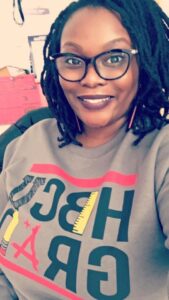
Antoinetta J. Rogers has seven years of teaching experience and currently teaches Secondary English at Richland Northeast High School.
By: Kim Ferrari, South Carolina English Teacher
If you were to look through my high school yearbooks, you would quickly notice one thing. Almost everyone was white. I grew up in a very white community in one of the whitest states in America and could probably count on my fingers the number of Black people I knew. As far as I knew, racism didn’t exist any more. The Civil Rights Movement and desegregation brought an end to it and everyone was treated equally now.
I moved to South Carolina in 2014 and learned very quickly that everything I thought I knew about racism and civil rights was wrong.
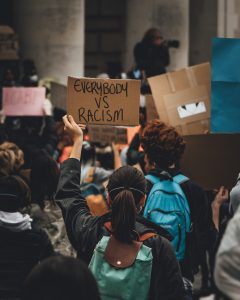
I watched the news in shock, horror, and disgust as the truth became apparent: racism is very much alive today. This new reality became something that I had to grapple with. I realized that I needed to relearn my nation’s history. For the first time, I began to realize that what is written in our history books is not the absolute truth. There are many untold stories in our history, stories which paint a different picture. As an educator working at a school with predominantly students of color, I knew that I needed to do better and educate myself.
To better understand the new reality and the new culture that I was now surrounded by, I turned to books (as any English teacher would). One of the very first books I read on my journey of truth was The Port Chicago 50 by Steve Sheinkin. I found myself on the verge of tears throughout the book, unable to believe that humans could be so cruel to one another. But then I turned on the news and saw the same types of things happening 60 years later.
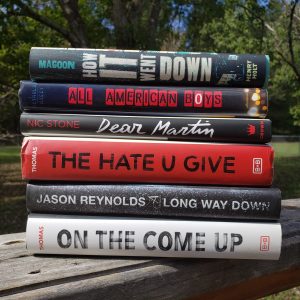
I continued reading books to help me process and understand what was happening around me, focusing on those books written by Black authors about Black youth. The first book that really made a difference was All American Boys by Jason Reynolds and Brendan Kiely. One of the main characters, Rashad, a Black teen falsely accused of stealing a bag of chips from a convenience store, could have been one of my students. This was the first time that I saw not just a character in a book, but a student in my classroom. It caused me to question my personal biases. Did I treat my Black students differently? Was I unfair in my discipline? Did my students all feel valued and seen in my classroom? These were difficult questions to ask myself and I didn’t always like the answers I came up with, but I owed it to my students to ask myself them.
The more books I read by Black authors and about Black teens, the more I learned about the injustices they face. Each book with characters like my students helped me to realize that when one of them calls out “Yo, Miss,” before asking a question, they’re not being smart with me. When a student is more interested in the latest music release or shoe drop than my Shakespeare lesson, it doesn’t mean I’m a bad teacher. These are just some of the things that they grew up with as part of their culture. A culture that I never experienced, but a culture that I can learn about through books.
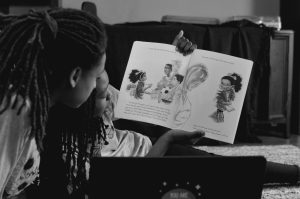
As police violence on Black people continues to happen, young adult novels like The Hate U Give by Angie Thomas, Dear Martin by Nic Stone, Ghost by Jason Reynolds, Long Way Down by Jason Reynolds, Ghost Boys by Jewell Parker Rhodes, and How it Went Down by Kikla Magoon have helped me to see perspectives that I hadn’t before. I saw these events through the eyes of my Black students and while I will never truly understand what it is like to be Black in America, these books offer me a window into their world.
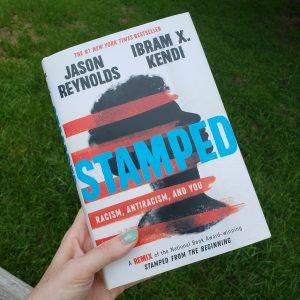
Most importantly, Stamped: Racism, Antiracism, and You by Jason Reynolds and Ibram X. Kendi taught me everything I never learned in school about slavery, racism, and segregation. What I thought I knew was challenged and I grappled with these new truths. Months later, I’m still questioning much of what I thought I knew about our nation’s history. This new (to me) information has helped me look at current events in a different light and to see how everything that happens today is connected to an event or decision in history.
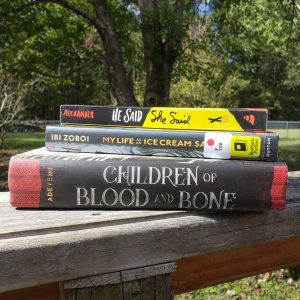
While there have been many books published in the last few years that center on the injustices faced by Black people and while it is important for everyone to read these stories, there is also importance in reading and amplifying stories of Black joy. Instead of focusing on how Black people have suffered, stories of Black joy celebrate being Black, being human, and living life. Books like The Crossover, As Brave as You, My Life as an Ice Cream Sandwich, and Children of Blood and Bone are just a few of the amazing stories of Black joy published in the last few years. With each book that I’ve read, I’ve learned about the importance of music, how different hair styles represent a person’s identity, and how stories are passed down from generation to generation to continue the culture.
All of these books have helped me to become a better person, educator, friend, and ally. My journey has been difficult at times but it is far from over; I recognize that I still have so much more to learn. Young adult literature will continue to be a powerful resource for me, allowing me to connect with my Black students and to see just some of the ways in which racism still exists in our country.
If you have never read a book that serves as a window into the life of a Black person in America, then I encourage you to read one. If you are White and have never read a book by a Black author, I challenge you to read one now.
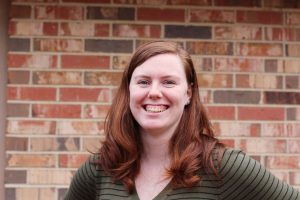
Kim Ferrari is an English Teacher at Manning High School in Manning, SC. She received her Bachelor of Science in Secondary English Education from the University of Maine at Farmington and is working on her Master’s in Literacy from Clemson University.
By: Dr. Jennifer Geddes Hall, Clemson University
Classrooms today are complex environments to navigate for teachers. There are standardized tests for almost every subject and grade level and teachers are expected to have every student, no matter the circumstances, pass these exams. They are expected to differentiate instruction based on the individual needs of each student all while being tasked with adhering to COVID health guidelines and participating in active shooter drills. Even more so today than in days of the past, teachers are responsible for addressing not only the academic needs of students but their social and emotional needs as well. Now that the racial unrest of our country, which has been around for decades, is more visible with violence against BIPOC and police brutality popping up on social media and news outlets, schools and teachers are charged with making their classrooms safe for all students.
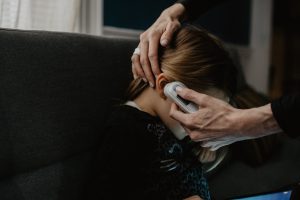
Safety is not ensured by having a school resource officer, locked doors for visitors who wish to enter, temperature checks at the door, or sanitizing stations at every corner. Safety outside of this context must address the culture of the school and the emotional safety and well-being of students from various backgrounds. What do I mean by emotional safety? Emotional safety includes feeling a sense of belonging in the fabric of the school and its community. Feeling safe enough to be vulnerable and share struggles and victories without fear of consequences or backlash. Feelings of togetherness and not otherness. In short, safety is created through positive relationships and unconditional positive regard.
Micro/macroaggressions can jeopardize this sense of safety and quickly create a negative school culture and harmful experiences for BIPOC students of all ages. Let’s first explore microaggressions. Microaggressions are commonly defined as subtle, degradations and putdowns -intentional or unintentional- disguised as jokes and/or compliments that are manifestations of racism and privilege which cause negative/harmful effects on the recipient. Some examples related to racial microaggressions include: Where are you from? You speak so clearly and eloquently! You don’t act Black. I’m colorblind. What are you? Can I touch your hair?

Although these may seem like “harmless” comments, they have great impact and BIPOC experience these types of interactions several times every day. Microaggressions such as these perpetuate the idea that BIPOC students are different, unusual, abnormal and can ultimately tear them down. Research has shown that the impacts of microaggressions can affect blood pressure, lower feelings of well-being and self-esteem, and increase stress, anger, frustration, anxiety, and depression. Outwardly it may appear that students are disengaged, verbally and physically aggressive towards peers and/or teachers, noncompliant, struggle academically, and/or drop out of school. Similarly, macroaggressions are obvious, larger scale or overt acts of aggression such as environmental macroaggressions and institutional/ideological macroaggressions (Compton-Lilly, 2020). Lack of BIPOC representation or items that convey racialized messages and areas within the school building or grounds that are racially insensitive such inadequate resources, inequitable policies/practices, and apathy in addressing impact of race or racial issues in the system are all examples of macroaggressions that may be occurring in our schools. These larger scale issues often lead to disproportionate levels of expulsion, suspension, and disciplinary actions against BIPOC students, increased negative attitudes and toxic school culture.
So how do teachers create safe spaces and help to positively impact change against micro/macroaggressions in their classrooms and schools? First off, teachers need to be open to examining and addressing their own implicit biases and areas of privilege. When we open our eyes to the messages about BIPOC that our society and environments have placed upon us, we can be more intentional about removing them from our way of being and interactions with students and others. We also need to be proactive in building relationships with all of our students and outwardly express our support for BIPOC. When we take time to connect, understand, and empathize rather than dismiss student experiences, we build relationships and trust. Research has demonstrated that when there is at least one caring, responsive, attuned person in a student’s life, it can impact the resilience and success of that student. Including representation of BIPOC and diversity in academic content and in classroom environments also conveys support. Representation is powerful.

When teachers hear others using or perpetuating microaggressions we need to intervene and stop them. This will demonstrate care and concern for our students, provide a model for others, and will help to decrease negative interactions that BIPOC students might experience during the school day. Instances of repeated or intentional microaggressions by students should be treated as bullying and addressed through the school’s bullying policy. Unfortunately, there are also instances of teachers and other adults in the schools who use microaggressions. These instances should also be addressed immediately and brought to the attention of administration for repercussions. Microaggressions of any kind are harmful but those initiated by adults in the school building have more impact due to differences in power, control, and privilege.
Finally, to address micro and macroaggressions teachers should communicate and collaborate with their school counselors in an effort to develop positive change in the school culture. School counselors are uniquely trained to address the mental health and emotional needs of students as well as advocate and implement data-based interventions for systemic change. School counselors have a larger view of issues in the school, access to data which can support needed efforts, ability to collaborate across many domains, and a seat at the leadership table by working closely with administrators. They have relationships with students, parents, and with adults in the school and community. Together, teachers and school counselors can work to focus on changes that need to be made in the classroom, such as bias that may be influencing grading practices or classroom lessons or group counseling interventions that may be necessary to build student skills related to cultural empathy. School counselors may also need to partner with teachers in providing cultural competency training to adults in the school and presenting school data on cultural climate to the school board/administration in an effort to improve conditions and policies/practices to ensure equity. I ask you to think about and consider what you will do in your classroom to take these steps forward? What actions will you take to make sure your school is a safe space for all? Change is not a choice, it is imperative.
For more resources on how to make classrooms more equitable and inclusive visit https://www.tolerance.org/
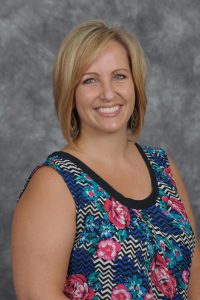
Dr. Jennifer Geddes Hall is an assistant clinical professor at Clemson University, teaching in the Counselor Education program and serving on the College of Education’s Community and Diversity committee and taskforce for Inclusive Excellence. She is a licensed professional counselor and certified school counselor with over 17 years of combined experience as a child/teen therapist and school counselor. Dr. Hall has worked in community and school settings in diverse, urban communities as well as rural areas. She has a focus on multicultural issues as well as developing cultural competency in her past publications as well as local, state, and national conference presentations. Dr. Hall currently serves on the board for the Association of Child and Adolescent Counseling (ACAC), a division of the American Counseling Association (ACA)